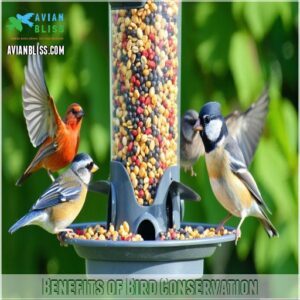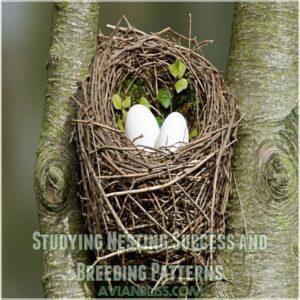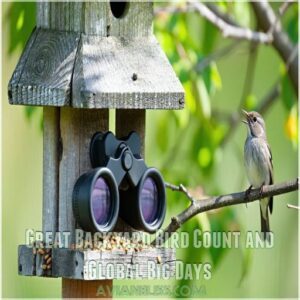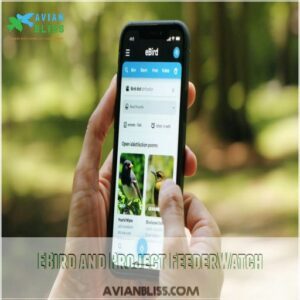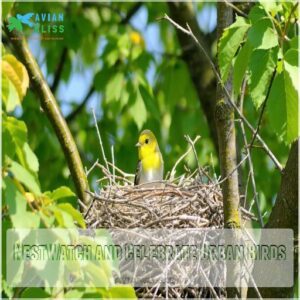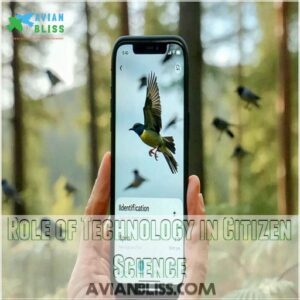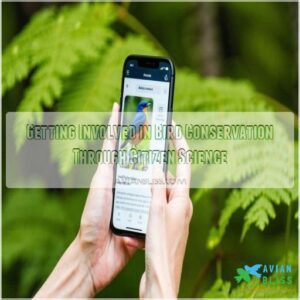This site is supported by our readers. We may earn a commission, at no cost to you, if you purchase through links.
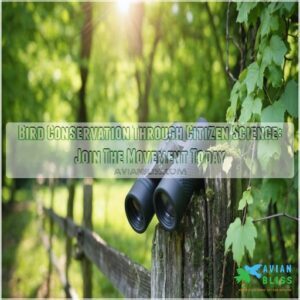
By participating in activities like bird counts, surveys, and monitoring programs, you collect essential data that scientists use to track migration patterns and understand habitat changes.
Imagine spotting a rare bird while sipping your morning coffee—it could be more than just a great story, it’s valuable data!
This effort connects you to a global community passionate about nature.
Curious about how your backyard can help save birds?
Stay tuned to discover projects that need your unique observations.
Table Of Contents
- Key Takeaways
- Benefits of Bird Conservation
- How Citizen Science Contributes to Bird Conservation
- Popular Citizen Science Projects for Birds
- Role of Technology in Citizen Science
- Applications of Citizen Science Beyond Birds
- How Citizen Science Inform Conservation Efforts
- Getting Involved in Bird Conservation Through Citizen Science
- Frequently Asked Questions (FAQs)
- How do I become a bird citizen scientist?
- How do scientists use data to help protect birds?
- How can citizen science improve conservation efforts?
- What is the eBird citizen science data set?
- Does citizen science contribute to environmental data collection?
- How can citizen science inform conservation and natural resource management?
- What is citizen science in conservation?
- Is eBird a citizen science project?
- What is the science of bird watching?
- Why does bird conservation matter?
- How do citizen science projects gather bird data?
- What challenges do citizen scientists face in bird projects?
- How do participants verify their bird observations?
- What species benefit most from these projects?
- How are local communities involved in bird conservation?
- Conclusion
Key Takeaways
- You can directly contribute to bird conservation by participating in citizen science projects.
- Your bird observations, even simple counts, help scientists make informed conservation decisions.
- Using readily available technology like smartphones and apps makes participation easy and impactful.
- Citizen science fosters community engagement and raises awareness about bird conservation issues.
Benefits of Bird Conservation
Protecting birds isn’t just about pretty feathers; it’s about maintaining healthy ecosystems. You’ll be amazed at how bird conservation helps everything from pollination to pest control, benefiting us all!
Importance of Bird Conservation
Bird conservation‘s essential role acts like nature’s safety net, balancing ecosystems and boosting biodiversity.
Birds deliver key ecosystem services like pest control and pollination, safeguarding food security and human health.
They also help us understand climate change impacts.
By participating in avian conservation through citizen science, you contribute to wildlife preservation, fostering a thriving environment for generations to come.
Threats to Bird Populations
Imagine waking up one day, and your favorite songbird isn’t chirping outside your window.
That’s the harsh reality facing bird populations due to habitat loss, climate change, pollution, invasive species, and disease.
As habitats vanish and Earth’s temperature climbs, these threats become life-altering challenges for birds, pushing them to the brink and leaving our skies a little emptier.
Role of Citizen Science in Conservation
In bird conservation efforts, citizen science is like a rallying cry that brings us together. You can help boost wildlife conservation by collecting data, joining bird monitoring programs, and learning about bird identification. By equipping yourself with the right gear from tools for citizen science projects, you’ll be well on your way to making a meaningful impact.
- Foster bird awareness and conservation data accuracy.
- Engage with volunteer motivation in projects.
- Explore the future of citizen science and its ethics.
- Strengthen the impact of citizen science efforts.
How Citizen Science Contributes to Bird Conservation
You can play a key role in bird conservation by joining citizen science projects that track bird populations and nesting success.
Even if you’re not a bird expert, your observations can help scientists understand how our feathered friends are doing, and who doesn’t love lending a helping wing?
Data Collection and Monitoring Programs
Citizen science boosts bird monitoring by gathering valuable data through engaging programs.
These improve data quality while tackling monitoring challenges.
Check out the comparison below:
| Aspect | Detail |
|---|---|
| Data Quality | Guarantees accurate recordings |
| Trends | Tracks population changes over time |
| Challenges | Overcomes limited professional reach |
| Techniques | Uses modern analysis methods |
| Effectiveness | Drives successful conservation efforts |
Dive in and enhance your understanding!
Participation in Bird Counts and Surveys
Joining bird surveys brings you closer to nature while contributing to conservation.
You can participate in:
- eBird: Track your sightings anytime.
- Great Backyard Bird Count: Engage every February with global enthusiasts.
- Christmas Bird Count: Join a historic census.
- Local bird counts: Add personal touches to community efforts.
Boost bird count accuracy, hone data analysis skills, and feel the joy of contributing!
Studying Nesting Success and Breeding Patterns
Understanding nesting success is key to bird conservation.
You can contribute by monitoring nests!
Let’s explore how your observations help scientists.
By participating in citizen science, you’re also helping address the pressing issue of habitat loss and climate change impacting bird populations, important factors in nest success.
| Project | Focus | Data Collected | Tools Used | Benefits |
|---|---|---|---|---|
| NestWatch | Nest success in US & Canada | Nest location, eggs, young | Observation sheets, photos | Understands impacts of habitat loss |
| Nest Quest Go! | Global nest monitoring | Species, egg count, fledglings | Smartphone app | Tracks global nesting trends |
| Celebrate Urban Birds | Urban bird nesting | Focal species nesting success | Observation, count sheets | Reveals urban nesting challenges |
| Bird Surveys | Breeding bird populations | Species, abundance, location | Binoculars, field guides | Monitors population changes, habitat needs |
| eBird | Bird observations, anytime, anywhere | Species, location, photos, audio | Smartphone app, website | Documents species distribution, abundance changes |
Your contributions help scientists understand nest success factors, breeding habitat needs, and the climate change impact on birds.
Even urban nesting patterns become clearer with your help.
Popular Citizen Science Projects for Birds
You’re invited to join popular citizen science projects like the Great Backyard Bird Count and eBird to help track bird populations and contribute valuable data.
These projects are fun and open to everyone, whether you’re a seasoned birder or just curious about the feathered friends in your backyard.
Great Backyard Bird Count and Global Big Days
Imagine stepping into the vibrant world of bird watching with events like the Great Backyard Bird Count and Global Big Days.
These citizen science projects make identifying and counting birds exciting, giving you a front-row seat in community science.
Jump in and contribute to meaningful bird research and data analysis, shaping the future of conservation while connecting with nature enthusiasts.
EBird and Project FeederWatch
eBird and Project FeederWatch are standout citizen science projects for bird lovers like you.
Ever wondered about seasonal trends or bird identification?
With eBird, your observations contribute to an immense database, enhancing data accuracy globally.
Project FeederWatch offers you a cozy winter pastime, counting birds at home.
Participation benefits include improving bird resources and engaging in meaningful conservation—imagine recording your feathered visitors with purpose.
NestWatch and Celebrate Urban Birds
NestWatch and Celebrate Urban Birds invite you to explore and protect bird habitats through citizen science projects.
Monitor nests with NestWatch to help scientists understand nesting patterns and threats.
Celebrate Urban Birds focuses on urban bird diversity, highlighting three actions: 1) Observe birds in your neighborhood. 2) Share your data online. 3) Engage local communities to raise awareness about conservation.
Role of Technology in Citizen Science
In today’s world, your smartphone can turn anyone into a citizen scientist, helping track bird populations faster than you can say "tweet."
With internet access and mobile apps, you’re part of a global team, gathering key data from the comfort of your backyard or on your next nature walk.
Impact of Internet and Smartphones on Data Sharing
The buzz around citizen science projects like eBird isn’t just about birdwatching; it’s about real-time data, too.
Thanks to the internet and smartphones, you can join online communities, ensuring your wildlife monitoring notes are shared instantly.
Mobile apps boost data accuracy, letting your observations reach scientists faster, like sending a text over coffee.
With the right Citizen Science Tools, participants can further enhance their contributions to these projects.
Here’s how:
| Benefit | Description | Example |
|---|---|---|
| Real-Time Data Sharing | Immediate uploading of observations | Bird sightings |
| Community Engagement | Connect with other bird enthusiasts | Online forums |
| Data Accuracy | Improved precision in reports | Smartphone photos |
| Citizen Science Growth | Expanding participant numbers | Broader reach |
Use of GPS Receivers and Mobile Apps
Smartphones and GPS changed everything.
Now, you can pinpoint bird sightings with amazing accuracy, boosting data quality.
Many apps, like eBird and NestWatch, make recording bird sightings a breeze.
They offer features like photo uploads and species identification, making citizen science easier than ever.
However, always check an app’s privacy policy before sharing your data.
Happy birding!
Future Advancements in Citizen Science Technology
Imagine a future where AI-powered identification and sensor networks enhance your birdwatching adventures.
Citizen science platforms will integrate virtual reality experiences, enriching species identification and data collection.
With advanced data analysis tools, like those on eBird, environmental monitoring will become a breeze.
These tech wonders promise to revolutionize citizen science, making participation more engaging and impactful than ever!
Applications of Citizen Science Beyond Birds
Citizen science isn’t just for the birds; you can join projects like bioblitzes to help identify various plant and animal species.
With online platforms like Zooniverse, explore diverse fields from tracking amphibians to transcribing ancient manuscripts—it’s science with a story, and you’re the hero!
Bioblitzes and Plant Monitoring Projects
Take your curiosity outdoors with bioblitzes and plant monitoring projects.
These initiatives are a chance for you to engage in identifying species and understanding plant phenology.
Fascinated by how climate impacts greenery?
- Observe biodiversity up close
- Help track seasonal changes
- Contribute to data analysis and conservation efforts
- Foster community involvement
- Boost your knowledge of environmental monitoring through citizen science
Insect and Amphibian Conservation Projects
Bioblitzes capture the wild world of biodiversity.
By applying the same principles that help protect birds from window collisions, we can adapt conservation efforts to the specific needs of other species.
Turn your gaze now to insect decline and amphibian threats—pressing issues that citizen science tackles.
Communities rally around projects like FrogWatch USA, listening for frogs’ love songs.
And BugGuide ignites curiosity by sharing insect snapshots.
Together, these efforts kindle conservation strategies and highlight our impact.
Keep wildlife hopping and buzzing!
| Project Name | Focus Area |
|---|---|
| FrogWatch USA | Amphibian calls |
| BugGuide | Insect sightings |
| Bioblitzes | Species diversity |
| Project FeederWatch | Bird feeding habits |
Zooniverse and Online Citizen Science Platforms
Thinking beyond insects and amphibians, explore Zooniverse and other online citizen science platforms. These projects let you contribute without leaving home. Handy, right?
You can even show off your passion with Zooniverse bird project merchandise Get Bird Gear Here.
- Zooniverse projects: Jump into space and history.
- eBird and Project FeederWatch: Perfect for bird lovers.
- Track wildlife or help researchers.
- Contribute data to the Cornell Lab of Ornithology and the Macaulay Library.
How Citizen Science Inform Conservation Efforts
You’ll discover how your bird observations, even simple counts, directly influence conservation decisions.
This data helps scientists prioritize protection efforts, leading to better policies and stronger bird populations – it’s your chance to make a real difference!
Using Data to Identify Conservation Priorities
Citizen science’s treasure chest of data fills in the missing pieces for conservation puzzles, guiding efforts where they’re needed most.
With tools like eBird and the Christmas Bird Count, everyday observations help map habitat, track species distribution, and reveal population trends.
These insights steer conservation plans, funding allocation, and species monitoring to protect bird diversity and forge effective conservation strategies.
Informing Policy Decisions and Management Practices
Sometimes, a simple observation helps shape big changes.
Through citizen science, you fill important gaps in data, enabling better bird conservation policy and management strategies.
Your records from eBird influence data-driven decisions on conservation plans.
These insights into environmental changes and species monitoring guide effective policies, showing the impact of communities committed to preserving our feathered friends.
Raising Awareness and Promoting Community Engagement
Jump into citizen science, and you’ll find volunteer opportunities that spark real change.
Through community outreach and education programs, you’re not just learning—you’re connecting people to the conservation community.
Social media campaigns and local partnerships amplify environmental awareness, making your voice count.
Join eBird projects, engage actively, and watch as your efforts nurture community engagement in conservation.
Getting Involved in Bird Conservation Through Citizen Science
You can play a key role in bird conservation by joining local citizen science projects and attending events designed for bird lovers like you.
Citizen science projects offer a variety of ways to participate, from logging sightings on online platforms to collaborating with scientists.
Whether it’s logging sightings on online platforms or collaborating with scientists, there’s a project for everyone, even if you sometimes mistake your neighbor’s cat for a rare bird!
Finding Local Citizen Science Projects and Events
Finding local citizen science projects is like discovering a treasure map to community engagement.
Check out the citizen science calendar for events like Celebrate Urban Birds.
Join bird clubs or scour social media for bird-friendly meetups.
Join directories, linking you with community-based projects like Nest Quest Go or the International Shorebird Survey.
Become a citizen scientist today!
Contributing to Online Platforms and Databases
Checking out local birding events gets you started, but contributing to online platforms like eBird or Project FeederWatch takes it up a notch.
These platforms let you record sightings, ensuring data accuracy and enhancing community engagement.
As a citizen scientist, your shared data becomes a treasure trove for tracking bird species and supporting key research.
Collaborating With Scientists and Conservation Organizations
Want to make a real difference? Team up with local conservation groups! Many citizen science projects partner with experts. You’ll gain valuable skills, contribute to wildlife research, and share your passion.
By using ethical bird photography practices, you can also capture stunning images while minimizing disturbance to the birds.
These partnerships boost community engagement and data sharing. It’s a win-win – you help birds, and you learn something new. Find a group near you and become a citizen scientist today!
Frequently Asked Questions (FAQs)
How do I become a bird citizen scientist?
Joining a bird citizen science project is easier than you think.
Start by participating in events like the Great Backyard Bird Count.
Use apps like eBird to record sightings, and enjoy connecting with nature and fellow bird enthusiasts.
How do scientists use data to help protect birds?
Scientists analyze citizen-collected bird data to track population trends, identify threats, and implement conservation strategies.
Your contributions help pinpoint declining species, measure habitat changes, and influence policy decisions.
You’re truly making a difference!
Ensuring vibrant birdlife for future generations.
How can citizen science improve conservation efforts?
Citizen science is a superhero of conservation, empowering you to collect essential data.
This collective effort improves strategies for protecting birds, tracking populations, and understanding habitats.
It also fosters community engagement and boosts awareness of environmental issues.
What is the eBird citizen science data set?
eBird is a citizen science project where bird enthusiasts like you submit observations of bird sightings.
This data forms a massive dataset used by researchers to track bird populations, distributions, and trends globally.
Conservation efforts are enhanced by this project.
Does citizen science contribute to environmental data collection?
Many hands make light work! Yes, you betcha! Citizen science projects, like eBird, massively boost environmental data collection. Your contributions matter, building a bigger picture of our planet’s health.
How can citizen science inform conservation and natural resource management?
By involving you in data collection, citizen science boosts conservation efforts and natural resource management.
Your observations help identify species trends, habitat health, and ecosystem changes.
Making it easier for experts to design effective strategies.
What is citizen science in conservation?
Think of citizen science as nature’s team sport.
You join others in collecting data and making observations that support conservation efforts.
Your participation helps scientists understand ecosystems, making management of natural resources more effective and inclusive.
Is eBird a citizen science project?
eBird is a fantastic citizen science project.
You can join millions globally to log bird sightings, helping scientists track bird populations and migration patterns.
It’s like a social network for bird lovers contributing to global conservation!
What is the science of bird watching?
Bird watching, like a window into nature’s secrets, is the science of observing birds in their natural habitat.
It involves studying bird behavior, migration, and species identification, contributing to citizen science projects and fostering conservation efforts.
Why does bird conservation matter?
Healthy bird populations are crucial for balanced ecosystems.
They pollinate plants, control pests, and spread seeds.
Their decline signals environmental problems, impacting us all.
Protecting them secures a healthier planet for everyone.
How do citizen science projects gather bird data?
Citizen science projects gather bird data through public participation in activities like organized counts, nesting studies, and multimedia contributions.
You can spot birds, record your observations, and share photos or audio, helping to monitor bird populations globally.
What challenges do citizen scientists face in bird projects?
You might face challenges like identifying bird species correctly, using complicated data entry tools, or dealing with harsh weather conditions.
Sometimes, finding enough time to participate can be tough too, balancing passion with life’s demands.
How do participants verify their bird observations?
Like a keen detective, you verify bird observations using field guides, online databases like eBird, and apps.
Collaborating with seasoned birders adds an extra layer of assurance, making the data reliable and community-driven.
What species benefit most from these projects?
Rare and declining species benefit most from citizen science projects, as they provide key data for their preservation.
Your participation offers valuable insights into species’ habitats and behaviors, helping guarantee their survival in ever-changing environments.
How are local communities involved in bird conservation?
Picture communities as forests where people, in collective harmony, join bird counts, monitor nests, and create urban bird havens.
Your efforts not only gather essential data but also foster awareness and inspire future generations to cherish avian life.
Conclusion
Honestly, who knew saving the planet could be as simple as birdwatching from your backyard?
By joining the bird conservation through citizen science movement, you help protect bird populations but also become part of a supportive global community.
Jump into projects like the Great Backyard Bird Count or NestWatch.
Your unique observations contribute essential data, fuel research, and inspire more people to protect our feathered friends.
Why not start today? We’ll discover this new hobby together!

